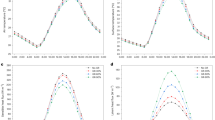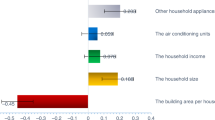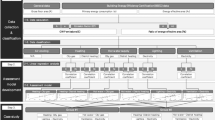Abstract
Reducing electricity consumption through green building certification is one key strategy for achieving environmental sustainability. Traditional assessments of the environmental benefits of green buildings rely on electricity consumption data at an aggregated level (such as monthly). Using such data can bias assessment results because marginal emissions factors vary throughout the day. We use panel data on hourly energy usage at the individual-building level from 2013–2016 in Arizona to provide a more accurate sustainability assessment for green buildings. For both Energy Star and Leadership in Energy and Environmental Design buildings, our estimated savings suggest that the majority of electricity savings in summer happen during electric load system peak hours. The estimated hourly savings and hourly marginal emissions damages reveal additional environmental gains in green-certified buildings. We show that traditional methods that ignore the intra-day timing of savings can underestimate the environmental benefit of green commercial buildings by 95%. We also demonstrate that our findings can be generalized to a broader geographical context.
This is a preview of subscription content, access via your institution
Access options
Access Nature and 54 other Nature Portfolio journals
Get Nature+, our best-value online-access subscription
$29.99 / 30 days
cancel any time
Subscribe to this journal
Receive 12 digital issues and online access to articles
$119.00 per year
only $9.92 per issue
Buy this article
- Purchase on Springer Link
- Instant access to full article PDF
Prices may be subject to local taxes which are calculated during checkout




Similar content being viewed by others
Data availability
The weather data are available from NOAA at https://www.ncdc.noaa.gov/cdo-web/. The Energy Star data are available from https://www.energystar.gov/index.cfm?fuseaction=labeled_buildings.locator. The LEED data are available from https://www.usgbc.org/projects. The high-frequency electricity data that support the findings of this study are available from the SRP, but restrictions apply to their availability. These data were used under a non-disclosure agreement in the current study, and so are not publicly available. However, they are available from the authors upon reasonable request and with permission from the SRP.
References
Electricity in the United States (US Energy Information Administration, 2017); https://www.eia.gov/energyexplained/index.php?page=electricity_in_the_united_states
Massetti, E. et al. Environmental Quality and the US Power Sector: Air Quality, Land Use and Environmental Justice (US Department of Energy Office of Science and Technical Information, 2017); https://doi.org/10.2172/1339359
Annual Energy Outlook 2018 (US Energy Information Administration, 2018); https://www.eia.gov/outlooks/aeo/tables_ref.php
Liang, J. et al. Do energy retrofits work? Evidence from commercial and residential buildings in Phoenix. J. Environ. Econ. Manag. (in the press).
Lstiburek, J. W. Why green can be wash. ASHRAE J. 50, 28–36 (2008).
Scofield, J. H. Do LEED-certified buildings save energy? Not really. Energy Build. 41, 1386–1390 (2009).
Scofield, J. H. Efficacy of LEED-certification in reducing energy consumption and greenhouse gas emission for large New York City office buildings. Energy Build. 67, 517–524 (2013).
Frankel, C. T. M. Energy Performance of LEED for New Construction Buildings—Final Report (New Buildings Institute, 2008).
Menassa, C., Mangasarian, S., El Asmar M. & Kirar, C. Energy consumption evaluation of US Navy LEED-certified buildings. J. Perform. Constr. Facil. 26, 46–53 (2012).
Siler-Evans, K., Azevedo, I. L. & Morgan, M. G. Marginal emissions factors for the US electricity system. Environ. Sci. Technol. 46, 4742–4748 (2012).
Koomey, J. & Brown, R. E. The Role of Building Technologies in Reducing and Controlling Peak Electricity Demand (Lawrence Berkeley National Laboratory, 2002).
Steinfeld, J., Bruce, A. & Watt, M. Peak load characteristics of Sydney office buildings and policy recommendations for peak load reduction. Energy Build. 43, 2179–2187 (2011).
Jessoe, K. & Rapson, D. Commercial and industrial demand response under mandatory time-of-use electricity pricing. J. Ind. Econ. 63, 397–421 (2015).
Qiu, Y., Kirkeide, L. & Wang, Y. D. Effects of voluntary time-of-use pricing on summer electricity usage of business customers. Environ. Resour. Econ. 69, 417–440 (2018).
How Many Smart Meters are Installed in the United States, and Who Has Them? (US Energy Information Administration, 2016); https://www.eia.gov/tools/faqs/faq.php?id=108&t=
Cooper, A. Utility-Scale Smart Meter Deployments: Building Block of the Evolving Power Grid (Institute for Electric Innovation, 2014).
Metoyer, J. & Dzvova, M. Expanding the Value of AMI Data for Energy Efficiency Savings Estimation in California (American Council for an Energy-Efficient Economy, 2014).
Boomhower, J. P. & Davis, L. W. Do Energy Efficiency Investments Deliver at the Right Time? (National Bureau of Economic Research, 2017); https://doi.org/10.3386/w23097
Novan, K. & Smith, A. The incentive to overinvest in energy efficiency: evidence from hourly smart-meter data. J. Assoc. Environ. Resour. Econ. 5, 577–605 (2018).
Burlig, F., Knittel, C., Rapson, D., Reguant, M. & Wolfram, C. Machine Learning from Schools about Energy Efficiency (National Bureau of Economic Research, 2017); https://doi.org/10.3386/w23908
Smith, N. New globalism, new urbanism: gentrification as global urban strategy. Antipode 34, 427–450 (2002).
Five of the Nation’s Eleven Fastest-Growing Cities are in Texas, Census Bureau Reports (United States Census Bureau, 2016); https://www.census.gov/newsroom/press-releases/2016/cb16-81.html.
Fowlie, M., Holland, S. P. & Mansur, E. T. What do emissions markets deliver and to whom? Evidence from Southern California’s NOx trading program. Am. Econ. Rev. 102, 965–993 (2012).
Shah, D. J. Enthalpy based thermal comfort controller. US patent 5675979A (1997).
Maheshwari, G. P., Al-Ragom, F. & Suri, R. K. Energy-saving potential of an indirect evaporative cooler. Appl. Energy 69, 69–76 (2001).
Holland, S. P., Mansur, E. T., Muller, N. Z. & Yates, A. J. Are there environmental benefits from driving electric vehicles? The importance of local factors. Am. Econ. Rev. 106, 3700–3729 (2016).
Chau, C.-K., Tse, M. S. & Chung, K. Y. A choice experiment to estimate the effect of green experience on preferences and willingness-to-pay for green building attributes. Build. Environ. 45, 2553–2561 (2010).
Altomonte, S. & Schiavon, S. Occupant satisfaction in LEED and non-LEED certified buildings. Build. Environ. 68, 66–76 (2013).
Heerwagen, J. Green buildings, organizational success and occupant productivity. Build. Res. Inf. 28, 353–367 (2000).
Singh, A., Syal, M., Grady, S. C. & Korkmaz, S. Effects of green buildings on employee health and productivity. Am. J. Public Health 100, 1665–1668 (2010).
Brown, M. A. & Southworth, F. Mitigating climate change through green buildings and smart growth. Environ. Plan. Econ. Space 40, 653–675 (2008).
Gill, S. E., Handley, J. F., Ennos, A. R. & Pauleit, S. Adapting cities for climate change: the role of the green infrastructure. Built Environ. 33, 115–133 (2007).
Updated Capital Cost Estimates for Utility Scale Electricity Generating Plants (US Energy Information Administration, 2016); https://www.eia.gov/analysis/studies/powerplants/capitalcost/
Berkhout, P. H. G., Muskens, J. C. & W. Velthuijsen, J. Defining the rebound effect. Energy Policy 28, 425–432 (2000).
Greening, L. A., Greene, D. L. & Difiglio, C. Energy efficiency and consumption—the rebound effect—a survey. Energy Policy 28, 389–401 (2000).
Gillingham, K., Kotchen, M. J., Rapson, D. S. & Wagner, G. Energy policy: the rebound effect is overplayed. Nature 493, 475–476 (2013).
Gillingham, K., Rapson, D. & Wagner, G. The rebound effect and energy efficiency policy. Rev. Environ. Econ. Policy 10, 68–88 (2016).
Levinson, A. How much energy do building energy codes save? Evidence from California houses. Am. Econ. Rev. 106, 2867–2894 (2016).
Newsham, G. R., Mancini, S. & Birt, B. J. Do LEED-certified buildings save energy? Yes, but…. Energy Build. 41, 897–905 (2009).
Linden, A. & Samuels, S. J. Using balance statistics to determine the optimal number of controls in matching studies. J. Eval. Clin. Pract. 19, 968–975 (2013).
Rubin, D. B. Using propensity scores to help design observational studies: application to the tobacco litigation. Health Serv. Outcomes Res. Methodol. 2, 169–188 (2001).
The 2013–2014 Resource Adequacy Report (California Public Utilities Commission, 2015).
Acknowledgements
Funding for this research was provided by the National Science Foundation under grant number 1757329. We thank A. Dock, L. Grant, M. Roberts and H. Bryan for helpful comments during preparation of this paper, and X. Bo for help with collecting the data.
Author information
Authors and Affiliations
Contributions
Y.Q. secured project funding, collected and cleaned the data, and conducted the statistical modelling. Y.Q. and M.E.K. designed the study, analysed the data and wrote the manuscript.
Corresponding authors
Ethics declarations
Competing interests
The authors declare no competing interests.
Additional information
Publisher’s note: Springer Nature remains neutral with regard to jurisdictional claims in published maps and institutional affiliations.
Supplementary information
Supplementary Information
Supplementary Notes, Supplementary Figures 1–11, Supplementary Tables 1–10
Rights and permissions
About this article
Cite this article
Qiu, Y., Kahn, M.E. Better sustainability assessment of green buildings with high-frequency data. Nat Sustain 1, 642–649 (2018). https://doi.org/10.1038/s41893-018-0169-y
Received:
Accepted:
Published:
Issue Date:
DOI: https://doi.org/10.1038/s41893-018-0169-y
This article is cited by
-
A synthetic dataset of Danish residential electricity prosumers
Scientific Data (2023)
-
Water conservation through plumbing and nudging
Nature Human Behaviour (2022)
-
Social Versus Private Benefits of Energy Efficiency Under Time-of-Use and Increasing Block Pricing
Environmental and Resource Economics (2021)
-
A Mobile Vehicle-Based Methodology for Dynamic Microclimate Analysis
International Journal of Environmental Research (2021)
-
Green commercial buildings save energy
Nature Sustainability (2018)



